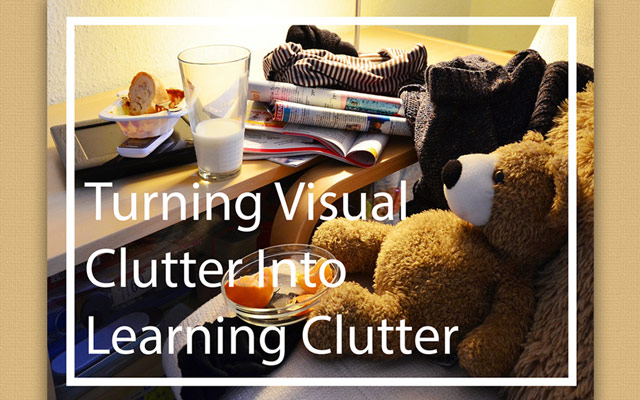Turning Visual Clutter Into Learning Clutter


Distractions seem like my nemesis. As soon as I settle in for a read-aloud it’s inevitable—my baby cries or my five-year-old gets into a fight with my toddler. For my kids, distractions are their secret weapon. They love finding something else to think about, look at, or read that isn’t the work at hand. I discovered that visual clutter is often the culprit. A messy, disorganized room creates a visual dissonance that can make learning more challenging, especially for a creative child. Each random object or book is a daydream waiting to happen. But simply cleaning up may not solve the problem. Visual clutter means open storage, stacked papers on a desk, even patterned wallpaper. But it’s impossible, or at least highly stressful, to make sure everything is always hidden to avoid this. A creative solution is to turn all the clutter into something that engages the mind and makes the mental distraction educational. A map hanging, a wall clock, and cork boards with the kids artwork on it, this “learning clutter” can fuel the imagination, and yes, still create a distraction, but it’s a step in the right direction. And—if you can’t fight the distractions—join them. Sometimes a child’s distraction just might teach them more! I’m learning a few tips to get their distractions on my side.
Learn visual strewing. Strewing is a way to create engaging learning by placing objects or games around the home for the kids to “happen upon” and learn from. Visual strewing is placing something related to the lesson on the walls. It’s important that it’s something they can’t understand immediately, something that spawns curiosity. Maybe you’re doing a unit study on the Revolutionary War; you could tape something red and something gray on the wall. When they ask about it, it spawns a discussion of the Redcoats and Continental armies.
Play classical music. Instrumental music curbs distractions by cloaking the room in a form of white noise. It’s proven that classical music makes it easier to focus; so during my kids individual work time, I try to have music playing. Also, when the mind is engaged with the music, the eyes are not so prone to wander about the room.
Dear reader, I hope you find some solace in the fact that distrations, as frustrating as they can be, are a normal challenge of life. Easily distractable kids can make homeschooling feel impossible—trust me, I know—but combating the distractions with learning-fuel can help a child to focus. Ask the Lord to give you rest and wisdom; each day presents its own challenges anyway. Allow this to be one of many things you give to Him!
Carole Ruffin is wife to Jesse and mom of five wonderful kids. She’s the author of Kids, Crayons, and Christ early elementary art curriculum, and also a graduate of the Cleveland Institute of Art. She vlogs art instructional videos for elementary students. Here’s her vlog: http://www.drawinguntohim.com/homeschool











































